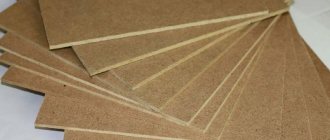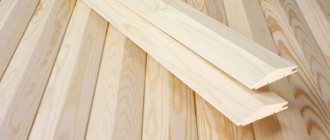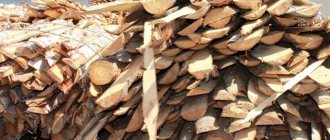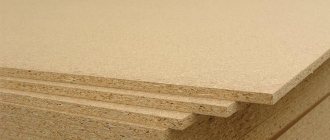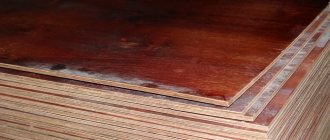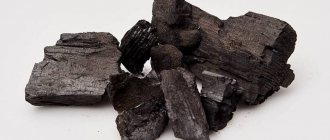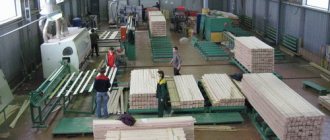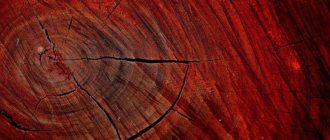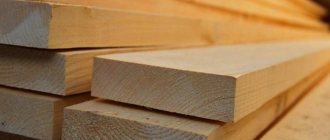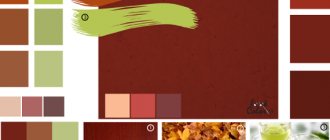Fiberboard, which is based on wood fibers, synthetic polymers and additives for density, is called fiberboard. All components are connected by hot pressing. In our country, most furniture is still made from fiberboard. This material is also used in carriage building. And in construction, partitions in rooms are made from fiberboard, and they are used for rough cladding of ceilings and even floors. Not long ago, laminated fiberboard appeared, which can be used for decoration. The material comes in different densities and degrees of water resistance.
What is fiberboard, scope of application
Fiberboard is an abbreviation for the name “Wood Fiberboard”. It is a sheet construction or finishing material. It has a relatively low price and can be of different densities - soft, hard and super hard. Sheet thickness - from 2-3 mm to 12-15 mm, some types can be up to 40 mm.
Fiberboards can be of different thicknesses and densities
Sheet fiberboard is characterized by high density and strength, and has a relatively low price. Thin sheets bend well, which allows them to be used for covering curved surfaces. Fiberboard is used in construction, as cladding in frame house construction, for leveling floors and walls. Partitions in railway passenger cars are also made from this material.
Low-density fiberboard is used as a soundproofing material. The chaotic arrangement of wood fibers causes sounds to “get stuck” in the material. This is the most inexpensive and easiest to install type of soundproofing materials. There are more effective ones, but you still need to look for cheaper ones.
Some types of fibreboards can be used as finishing materials - for finishing walls in rooms with normal humidity. For these purposes, fiberboard is used, one of the sides of the sheet is painted, covered with a decorative film, or laminated.
These are options for decorative finishing
Another area of application for fiberboard is furniture production. Usually this material is used as an auxiliary material - they make the back wall of cabinet furniture, hem the bottoms of armchairs and chairs, the bottoms of drawers, etc. In general, the scope is wide. There is essentially only one drawback - without hydrophobic additives, the material behaves poorly at high humidity. It swells, increasing in size. In this case, the sheet material “goes in waves.” When it dries, it remains deformed. So in unheated or damp rooms it is possible to use only certain brands of fiberboard.
Treated fibreboards (DVPO)
The distinctive advantages of ennobled fiberboards are their beautiful appearance, high resistance to abrasion and moisture. In the production of this type of board, a technology is used that involves applying a multilayer coating to the front side. After careful processing, a primer layer is applied to the surface to create the background part. Then a design is printed that imitates the structure of wood.
Treated slabs are used to make doors, as a material for finishing ceilings and walls, etc. They are also used to make various internal furniture parts (bottom and back walls of cabinets, drawers, etc.).
Production technology
The starting materials for the production of fiberboard are waste from the wood processing industry: wood chips, sawdust, firewood (woody parts of the stems of spinning plants). The raw materials are washed, foreign inclusions are removed from them, and then dried. The dried material is crushed in special machines (defibrators and refiners) into small particles - fibers. The degree of grinding can be from coarse to fine. Further, the process differs for different production methods.
Feedstock for fiberboard production
Pressing takes place under high pressure - 3-5 MPa and high temperature - above 300°C. Due to this, the bonding and compaction of the material occurs. Before pressing, additional components are added to the source material to change the properties of the material - binders (synthetic resins), water repellents, fire retardants, etc.
Forming methods
There are two ways to produce fiberboard - wet and dry pressing. The “wet” method is more environmentally friendly. When wet pressing, fewer binders are used (sometimes without synthetic additives at all), but the material is more expensive, since the process is more energy-intensive. It takes up to 15 minutes to dry one sheet, which limits the productivity of the presses and, therefore, increases the price of the material. With this method, the necessary additives and water are added to the crushed material. The slurry enters the dispenser, which spreads it in an even layer on the belt. For faster water removal, the tape has a mesh structure. After passing through the press, the back side of such fiberboard has an imprint of this fine mesh.
When wet pressing, some types of fiberboard can be made without adding any foreign binder. Under pressure and at high temperatures, lignin (a substance that characterizes the woody walls of plant cells) is released from wood fibers. It is a natural binder. Lignin is found in significant quantities in coniferous wood. But not all types of fiberboard need a natural binder. In this case, from 4 to 7% of a synthetic binder is added.
The type of molding can be easily distinguished by the back side of the plate
When dry pressing, synthetic resins are usually added to the mass, which bind the fibers. It is this method that makes it possible to obtain fiberboard of large thickness - up to 12-15 mm; some factories can produce pits up to 40 mm thick. Compaction and pressing of dry mass takes much less time - 3-5 minutes, depending on the class and thickness. The productivity of the press increases significantly. In addition, fewer additives are added to the dry mass - they are not washed out with water. All this leads to a reduction in the cost of the material. But cheap binders contain formaldehyde, and its content must be controlled, since in large quantities it is harmful to health.
For the production of furniture and interior finishing work, material with a formaldehyde emission class of E0.5 or E1 must be used. This is usually wet-pressed fiberboard. You can distinguish fiberboard made using the wet method by the mesh imprint on the back of the sheet (see photo above).
Final processes
During high-temperature pressing, particles stick together. The time spent under the press is not always enough, so the already formed sheets are transferred to a special chamber, where the “ripening” of the material occurs at high temperatures. The fiberboards are kept here for several hours. During this time, the fibers are sintered and glued together, the material becomes homogeneous and durable.
Fiberboards have different thicknesses
The slabs leave the chamber with almost zero humidity and begin to actively absorb moisture from the air. As a result of this process, the edges of the sheets swell. To avoid this drawback, the material is transferred to another chamber, where it is brought to normal humidity. And only after this, the fiberboard sheet can be sold or used on other machines - for painting, laminating.
What's good is that fiberboard technology is flexible. The press can have any shape, which allows you to make not only sheet material, but also shaped products. For example, baseboards or furniture fronts.
Where can you buy high-quality building materials?
Today there are a huge number of retail outlets in the country where you can purchase building materials for any request. Each store tries to expand its range, according to consumer requirements and the emergence of new products on the market.
It is more profitable to buy fiberboard panels in bulk than individually
Repair and construction work is a very responsible and painstaking undertaking. You need to approach the selection of the necessary materials with all responsibility and care. Having studied in detail the pricing policy of construction stores, you can choose the most suitable option for yourself.
Helpful advice! It is convenient to purchase the necessary materials in large construction stores, where there is a wide range of products, and specially trained consultants will help you choose exactly what you need.
One of these large hypermarkets is the Epicenter store, which offers a wide range of goods covering all areas of human life. Products are divided into categories and clearly displayed in the sales areas. Additionally, you can order items that are currently out of stock.
In the Epicenter network, the price per sheet of fiberboard is optimal, and the availability of positions from different manufacturers makes it possible to select the required product in one place, which will save time.
The price of fiberboard is affected by the size and thickness of the sheet
To purchase construction products, you can use the services of online stores. Many such structures work directly with manufacturing plants, which determines the cost of products, which is an order of magnitude lower than that of competitors. You can place your order without leaving your home at any convenient time. And the fast delivery service will allow you to receive the goods at the specified location in the shortest possible time.
The modern range of fiberboards is very diverse. Anyone can choose a worthy option for themselves, based on their scope of application of fiberboard and their own financial capabilities. If you choose the right building material, having previously studied the pricing policy for your region, you can get a good product for a very reasonable price.
Related article:
Fiberboard: what is it?
How to choose the right building material History of the material. Main types of fiberboard and criteria for choosing fiberboard. Areas of use. Advantages and disadvantages of the material.
But we should not forget that the higher the quality of the raw materials, additional components and the more reliable the level of pressing, the better the quality of the final product and, accordingly, the higher its cost.
Source
Types and classes
The main classification of fiberboard is by purpose and density. According to their intended purpose, fibreboards are of general and special types. Special - these are with some special properties. Three main groups can be distinguished:
- Moisture resistant (bituminized). When preparing the mixture, bitumen is added to it, which improves resistance to moisture.
- Difficult to burn. Fire retardants are added to the starting material, which reduce the flammability of the finished material.
Thin sheets bend well, thick sheets have high rigidity, so the material can be used for different purposes. - Finishing - with one side refined. The front side of the fiberboard can be painted, glued with a polymer film that imitates various materials: wood, stone, brick, tile, etc.
Finishing types of fiberboard - with one side treated - are also classified as special-purpose materials. There are a lot of subspecies and they can be called differently:
- Fibreboard with a lined or painted surface, smooth on the back (produced by dry pressing). In colloquial speech, such material is usually called “hardboard”. This is usually a medium density material.
- The same thing, but with a non-smooth back surface, is called “masonite” (wet pressing).
Sheathing a dacha with fiberboard is a common solution - If the front side of the material is glued with film - laminated - this material is called laminated fiberboard, sometimes the abbreviation LDVP is found.
General purpose fiberboard is also called construction fiberboard. This class can include materials of both dry (with two smooth surfaces) and wet production methods.
Price or quality?
Typically, the main criterion when choosing general-purpose fiberboard is low price. If you use it to cover the frame, a lot of material is required, so you want to save money. But you shouldn't chase cheapness.
The quality of fiberboard is determined by the absence of foreign inclusions or delamination
Cheaper fiberboard sheets are made with more formaldehyde. This substance in large quantities contributes to the development of cancer. To make your home safe, you should not use material with an emission class higher than E1 for interior cladding. Materials with class E1 are absolutely safe. They emit as much formaldehyde as natural wood.
Decorative panels for walls
Facing a room with sheet material will help to perfectly hide all existing imperfections in the wall surface, protect against mechanical damage, and also provide a decorative finish. This is an imitation of wood, stone, brick. This building material is easy to use, has a low cost and is actively used in construction. Fiberboard has created a revolution in the construction industry. Wall panels made from fiberboard can be placed in a variety of ways. And at a certain angle, both horizontally and vertically.
Working with fiberboard does not present any difficulty, so even a beginner in construction can do it. One of the leaders among fiberboards for wall cladding is a special panel made with a decorated front side. MDF is also used as a wall covering. This building material is a leader among competitors due to its quality indicators and optimal cost.
Externally, the fiberboard sheet is similar to chipboard (laminated wood board or plywood), but its second side is different - it has decor on it. For finishing work in the kitchen, both smooth and embossed textures can be used. The length of a standard size sheet is 3.0 m. The thickness of the panel is 3-6 mm.
Any type of fiberboard is not difficult to use. However, this building material is afraid of high humidity. In this regard, it is better not to use it near the kitchen sink. But for other places in the kitchen, fiberboard is perfect as a wall panel.
The panels are characterized by their original appearance, ease of installation, and a small number of joints. Also, fiberboard is the optimal building material in terms of price - 600 rubles/m2. These wall panels can last up to several decades. But the main requirement for such a service life is the absence of direct exposure to water and air humidity within normal limits.
Density, weight, thickness of sheets
The technology for the production of wood-fiber boards allows them to be made in different densities. Depending on the density, they have different technical characteristics and areas of application. There are the following types of fiberboard:
- Low density. They are also called soft, they can be designated using the attached letter “M” - DVP-M. Quite loose material with a density of 200-350 kg/m³. Sheet thickness can be 8, 12, 16, 25 mm. If desired, you can find up to 40 mm. They are usually used for sound insulation or as finishing/cladding in areas not subject to load.
Low-density fiberboard has a loose structure, used as insulation and sound insulation - Medium density - up to 850 kg/m³, sheet thickness can be 8, 12, 16, 25 mm. They are also classified as soft.
- Semi-solid - from 860 to 900 kg/m³, sheet thickness 6, 8, 12 mm.
- Solid (fibreboard T) - 950 kg/m³, sheet thickness 2.5, 3.2, 4.5 and 6 mm.
- Super-hard (Fiberboard-ST) - 960-1000 kg/m³, can be 2.5, 3.2, 4.5 and 6 mm thick.
Hard and super-hard grades are used where resistance to mechanical stress is important. In domestic construction and finishing of houses/apartments, fiberboard-T is placed on the floor, and walls can be sheathed with it.
Types of solid slabs
With all this, general-purpose solid fiberboards come in several types - with different front and back sides. According to GOST, solid fiberboards are marked as follows:
- T – solid slabs with an untreated front surface. Often also called “technical” fiberboard. Used for work in which appearance is not important.
- T-P - solid slabs with a tinted front layer. This is the so-called hardboard. Used in the furniture industry for back walls in cabinets, tables, etc.
The choice of colors is wide - T-S – solid slabs with a front layer of fine wood pulp. One side of the sheet has the same color, but is smooth, as if varnished. Can be used for cladding frame buildings from the inside. Requires minimal finishing work. You can paste wallpaper onto such a rhinestone surface, but removing it will be very inconvenient. But the putty does not fit well on a smoothed surface - it rolls off.
- T-SP - solid boards with a tinted front layer of finely ground wood pulp. Can be used as a finishing material.
Brands of hard fiberboard can be of two classes - A and B. They are distinguished by quality. As you can see, even in the same class there are different materials. With the same (or almost identical) technical characteristics, they have different areas of application.
Subtypes of super-hard fiber boards
Super-hard wood-fiber boards are rarely used in household construction and repairs - the price is too high, and high density and rigidity may not be in demand. Sometimes being too firm can be uncomfortable.
According to the standard, there are two types of such material:
- ST
is a “construction” brand, not very attractive in appearance; - ST-S
– with a smooth face layer - finely ground wood pulp is compacted to a very smooth state.
Dense and smooth slabs
There are practically no laminated or decorative types - a material that is too heavy and hard for finishing is also not needed.
Names depending on density
Fiberboards also have different names depending on their density. Usually this is a tracing paper (transliteration) of English/international names. Although the same name often means a different material in other countries.
- LDF - from the English low density fiberboard - LDF. Translated - low-density fiberboard. In fact, this is the name for a medium-density material that simply has characteristics at the lower boundary of the zone. Has nothing to do with soft wood boards.
Characteristics of MDF - MDF - from the English medium density fiberboard - MDF. In translation - medium density fibreboard. If we talk about standards, then this material meets the GOST definitions of medium-density fiberboard.
- HDF - high density fiberboard - HDF. According to the characteristics, the grade Fiberboard-T (solid) can be assigned.
HDF boards are usually thin and are used for routing patterns.
As you can see, there is no clear distinction. Adding to the confusion is the incorrect use of names. In general, each time it is necessary to clarify what exactly the speaker means by this or that term.
Dimensions
It makes sense to talk about sizes only in relation to standard sheets or slabs. As mentioned earlier, the thickness of fiberboard sheets can be from 2 to 40 mm. The remaining sizes are determined by the standards:
- width 1220 mm and 1700 mm;
- height 2140 mm, 2440 mm, 2745 mm.
Dimensions are determined by standards.
Please note that in any production you can find non-format sheets. After molding in the press, they are trimmed, and sometimes, due to malfunctions of the equipment (which forms the carpet on the belt), the edges have to be trimmed more. Because of this, narrower or shorter sheets are obtained. If you don't care about the standard size, you can always buy these. In quality they are unlikely to differ in any way, but in price they will be much lower.
Super hard slabs
This material is characterized by high quality workmanship, ease of processing and ease of installation. It has an increased density, the values of which are at least 950 kg per cubic meter. meter. The material acquires high hardness by impregnating the fiberboard sheet with pectol. What it is? Pectol is a by-product from the processing of tall oil. Superhard boards are used for construction purposes for the manufacture of doors, arches, partitions, and for the production of various types of fiberboard containers. On the floor are used to make floor coverings.
Modern use of some species
If we talk not about construction, but about finishing work, then the name “MDF” - a medium-density fibrous material - has begun to appear more and more often in this area. Interior doors are made from laminated sheet MDF. A frame made of wooden planks is sheathed with this material, resulting in budget products that look very good. Soundproofing characteristics depend on the type of frame filling, and the durability of the product itself depends on the quality of lamination and the rigidity of the film.
Any relief can be formed from wood fiber mass
Production technology makes it possible to create not only sheet wood-fiber products. Theoretically, the shape of the press can be any. Therefore, various types of moldings began to be made from MDF - platbands for finishing the same door frame, baseboards and other similar products. They can be matched to the color of the doors and similar in shape.
Such smooth lines can only be made using wood or MDF
The facades of cabinet furniture began to be made from MDF. For example, kitchen ones. Moreover, if furniture made from chipboard has a linear structure, curved, smooth, rounded shapes are formed from ground wood fibers. All this allows us to create greater species diversity. Using the same technology, MDF wall panels are made. These are not only even, smooth sheets, but also with patterns of different types/types.
Tough fibrous materials
HDF, a high-density material, is used in some areas. In particular, due to its rigidity, it is convenient to work with when forming openwork. Using laser cutters, slotted openwork is formed on thin laminated or painted HDF boards. Various decorative elements are made from openwork slabs, in particular, screens for radiators.
Perforated HDF is good for decoration
Some types of finishing materials are formed from HDF. The plate is covered with a layer of film or painted. The surface can be smoothly painted, imitate wood, stone surface, etc. If the material is molded in the form of strips with locks, the same laminate is obtained. If the material is made in the form of sheets, they can be used to cover walls, ceilings, and be used to decorate the work area in the kitchen - a kitchen apron.
Surely there are other areas of application of fiberboard of different densities. And, most likely, there will be other uses. The technology is flexible and allows the production of materials with different properties.
The procedure for preparing the base
The rough foundation for fiberboard necessarily requires proper preparation. To do this, it is imperative to remove the baseboards along the walls so as not to interfere with the work. Wooden floors are carefully inspected for strength and integrity - it is important to pre-fix any loose boards. Significant unevenness in the floor is corrected - they are planed. This procedure is not easy, and it is better to use special equipment, which you can rent or call a specialist who has it.
Alignment by scraping
Also, measures to prepare the base include careful removal of construction debris, sweeping of dust, and sealing cracks in the floor with putty.
Advice! In old buildings, wooden floors are additionally treated with antifungal mixtures.
Old wooden floors need to be properly prepared
